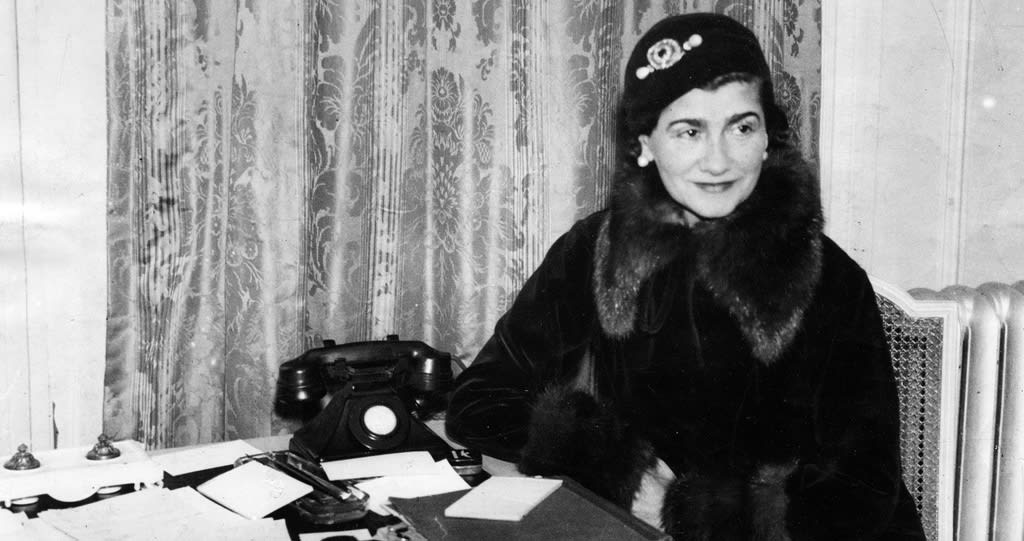
Before knowing how trousers came to be the revolution of the ones who, after World War II, wanted independence for themselves, it is important to acknowledge a well-known fashion designer —who stayed afloat with the help of Nazi sympathizers, — Coco Chanel. An anti-semitic, who used her connections to comfortably live at the Ritz Hotel during the second world war with her German boyfriend, Baron Hans Günther von Dincklage, an officer in Abwehr, who kept her in high society.
Coco Chanel
During World War II, Coco Chanel stayed in Paris and her affiliation with the Nazis benefited her business interests: repossessing her perfume company, in the hands of two Jewish brothers (Pierre and Paul Wertheimer). Prior to this, in 1924, the Jewish Wertheimer family backed the launch of her perfume in exchange of most of the profits. Then, when the "Aryanization" laws forced Jews to give up their businesses, Chanel saw an opportunity to reclaim a lucrative part of her empire.
However, in 1940, both brothers gave the company to a French catholic, Felix Amiot, fleeing afterwards to America to escape the persecutions that the Jews were being targeted. And, by the end of the war, they managed to regain control of the company, which started a judicial war that culminated in mutual agreement, between brothers and Chanel.
Due to this, Chanel received profits from sales of Chanel No. 5 during the war, an amount equivalent to eight million euros (nine million dollars). It was also decided that, from then on, she would receive 2% of all perfume sales, worldwide. On top of that, Pierre Wertheimer agreed to pay all the stylist's expenses for the rest of her life.
During her ongoing business interests, Coco Chanel emerged her anti-semitic ideas and Nazi affiliations by carrying out, on behalf of Abwehr, various missions, traveling to Madrid and Berlin. Where, in Madrid, she was tasked with obtaining "political information" with Vaufreland, a French traitor, under the disguise of business dealings. And sometime in 1941, she was registered as Agent F-7124, with the code name of "Westminster," after her former lover, Hugh Grosvenor, 2nd Duke of Westminster.
Despite her services for Abwehr, she fled to Switzerland and escaped punishment, contrary to what happened with other military personnel and collaborators of the regime, accused of war crimes.
‘According to Sleeping with the Enemy, Chanel also took care to erase evidence of her actions, where possible. Upon learning that an ailing Schellenberg was planning to publish his memoir, Chanel paid his medical bills and ensured his family was on sound financial footing; the subsequent memoir had no mention of her involvement as an agent.’ (1) Ultimately, Chanel never endured any ramifications for her wartime dealings with the Nazis.
She returned to Paris after the war, in 1954. It was at that time that she focused on rebuilding Chanel, aided by the very same Wertheimer family she had fought for so many years, and lived out her years as a celebrity, before her death at the Ritz Hotel in 1971.
Course of Fashion
As explained, during WWII, Chanel kept herself in high society due to her Nazi affiliation, along with a life full of secrets and friendships with rich and powerful people. However, despite this role, it’s said that Chanel changed the course of fashion, capitalizing on the changing times.
To know what led to this change, we need to go back to when WWI broke out in 1914. Before the war, women weren’t allowed to wear pants and when men went to join the military, they started working in traditionally male jobs as a result. Manual roles required movement and dresses did not comply to those norms thus wearing trousers and overalls became common at the workplace.
At that time, Coco Chanel was the most influential fashion designer and not only did she popularize trousers as a fashion item, she also introduced other items to day-to-day life, such as fake pearls, suntan, the little black dress and others.
That said, Coco Chanel often wore trousers by borrowing her boyfriend’s (Hugh Grosvenor) suits. This ‘trouser popularity’ came while she was at the society beach resort of Deauville, where she chose to wear sailor’s pants instead of a swimming costume to avoid exposing herself, which was spread quickly as her legions of followers emulated her.
Therefore, she began designing trousers for women to wear while doing sports and other activities, plus trousers soon became a fashion choice for women rather than merely a functional garment. Her pants were designed high waisted that flattered every figure, something distinctive to her design.
In the end, the designer regretted how her careless decision affected the course of fashion history. Aged 86 she said: “I came up with them by modesty. From this usage to it becoming a fashion, having 70% of women wearing trousers at evening dinner is quite sad.” (2)
References
(1) Ott, T. (2019). Coco Chanel's Secret Life as a Nazi Agent. Famous Biography. [https://www.biography.com/news/coco-chanel-nazi-agent Retrieved 05/13/2020].
(2) Dunne, L. (2013). Seven Wonders: How Coco Chanel changed the course of women’s fashion. Wonderland. [https://www.wonderlandmagazine.com/2013/09/04/seven-wonders-how-coco-chanel-changed-the-course-of-womens-fashion/ Retrieved 05/13/2020].
Further Bibliography
Bernardino, A. L. (2019). Coco Chanel. Como a estilista se tornou numa agente secreta para o regime nazi. Sapo Magg. [https://magg.sapo.pt/atualidade/atualidade-internacional/artigos/coco-chanel-como-a-estilista-se-tornou-numa-agente-secreta-para-o-regime-nazi Retrieved 05/13/2020].
Hayford, A. C. (2015). Ten ways Coco Chanel changed fashion. Hunger. [https://www.hungertv.com/feature/ten-ways-coco-chanel-changed-fashion/ Retrieved 05/13/2020].
How Coco Chanel Changed the Fashion Industry Forever. FemFace. [https://femface.net/how-coco-chanel-changed-the-fashion-industry-forever/ Retrieved 05/13/2020].
Ewing, Elizabeth. History of Twentieth Century Fashion. Revised by Alice Mackrell. Lanham, MD: Barnes and Noble, 1989 [http://www.fashionencyclopedia.com/fashion_costume_culture/Modern-World-1930-1945/Trousers-for-Women.html Retrieved 05/27/2020].





Comments
There are no comments for this story
Be the first to respond and start the conversation.